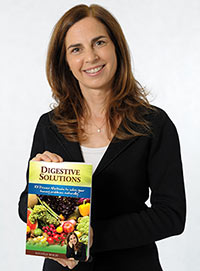How to curb cravings
By Michèle Wolff B.H.Sc Naturopathy, Dip. Colonics and Author of ‘Digestive Solutions’
We’ve all been faced with that niggly thought that comes out of nowhere and won’t go away. Chocolate…. Mmmm, chocolate… want… need… now! Insert biscuits / sugar / crisps / dairy as appropriate; whatever your poison, when the craving hits it’s hard to ignore!
However, by listening closely to our bodies it’s not difficult to beat cravings – we just need to understand what our bodies are telling us.
There are various reasons we crave certain foods or food types: addiction, allergy, dietary imbalance, or emotional.
Addiction: Just as nicotine is highly addictive, so too are many foods. In 1900 the average person ate 5kg of sugar per year, now it’s increased to 75kg and is extremely destructive to our health. It’s relatively easy to become addicted to sugar or caffeine, and as anyone who’s tried to cut back on coffee will know, if you miss your morning latte, you can experience headaches, digestive upset, mood swings and more. Another cup of coffee will often get rid of the symptoms – so the addiction feeds the craving.
Allergy: Often, we crave what we are intolerant or sensitive to, causing physical symptoms and sometimes mood changes. By avoiding these foods until the gut is healed, you may be able to tolerate it again. There are simple ways to test for mild food allergies, including the pulse test (see sidebar)
Dietary imbalance: Cravings often arise from a dietary imbalance. A craving for sweets and refined flour can be caused by eating too much protein and fat. A fungal infection may result in sugar cravings, as bad bugs in the intestine love to feed off sugar. Cravings from an acid / alkaline imbalance are strong. Although alkalising foods like salads and fruit are generally positive, too much will cause you to want more acidic foods to balance your body. Without protein and grains, the craving for acid-forming sweets will be high.
Emotional craving: Sometimes, our emotional states can trigger desires for certain foods. So for many Aussies who feel under the weather, vegemite on toast takes them back to their childhood. If you feel sad, you may automatically reach for the ice cream or a chocolate bar. And sometimes, if we’ve denied ourselves certain foods, we can become fixated on them and end up bingeing.
Understanding WHY we want certain foods is key to getting cravings and binges under control.
For addictions and allergies, it’s important to avoid the culprit foods. The symptoms of withdrawing from addictive foods like sugar and coffee are short-lived, so abstaining will reap rewards in a short period of time.
For dietary imbalances, and emotional cravings:
- If you crave sugar, then have more whole grains and less salt and dairy. If you crave sugar before a period, eat more magnesium rich foods like buckwheat and brown rice.
- If you crave coffee, have more vegetables and salads, and cut down on meat and sugar. You can use chicory or dandelion to replace the taste, or drink green tea for less caffeine.
- If you crave dairy, eat more leafy greens, brown rice and fish, and avoid sugar and fruit. Use nut milks instead, and keep up other calcium-rich foods like boned fish, almonds and tahini.
- If you crave alcohol, have more healthy carbohydrates and bitter greens, and eat less fat, salt and animal protein.
By identifying your triggers for emotional over-eating, you can develop strategies for coping that don’t include bingeing. These could include going for a quick walk, reading a book or magazine, or opting for a healthier snack instead.
To check for allergies using the pulse test, follow these simple steps:
1. Take your baseline pulse by counting your pulse for a full minute in a resting position, before eating a food.
2. Put a single food in your mouth on your tongue. Let it sit on your tongue so you can taste it for about two minutes.
3. Retake your pulse (sitting in the same position as when you took your baseline pulse) while the food is still in your mouth. An increase of 10% or more may be considered an allergic or sensitivity reaction. The more sensitive you are, the faster your pulse will be.
4. Spit the food out, rinse your mouth with purified water and spit the water out. After two minutes, re-take your pulse to compare with the baseline result. If it hasn’t returned to baseline, wait another 10 minutes. Once your baseline pulse has returned to normal, you can test another food.
5. If you experience an increased pulse rate, taking the test twice more can help rule out other factors. Note: If you have a diagnosed allergy, or are concerned you may have a serious reaction to a food (such as anaphylaxis, or if you have an EpiPen) then please don’t try this sensitivity test on yourself.






